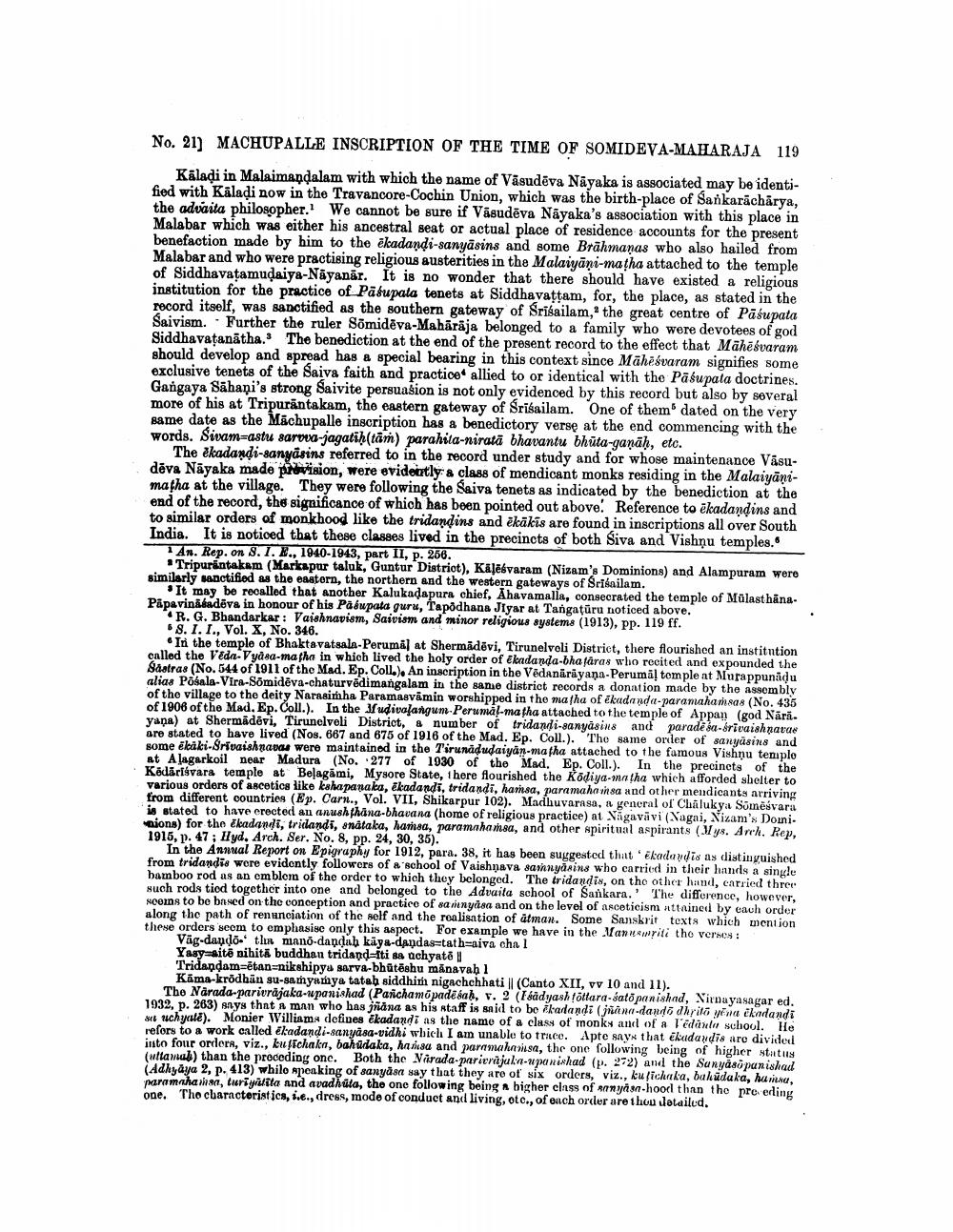________________
No. 21) MACHUPALLE INSCRIPTION OF THE TIME OF SOMIDEVA-MAHARAJA 119
Kaladi in Malaimandalam with which the name of Väsudēva Nayaka is associated may be identified with Káladi now in the Travancore-Cochin Union, which was the birth-place of Sankaracharya, the advaita philosopher. We cannot be sure if Vāsudēva Nayaka's association with this place in Malabar which was either his ancestral seat or actual place of residence accounts for the present benefaction made by him to the ekadandi-sanyasins and some Brāhmanas who also hailed from Malabar and who were practising religious austerities in the Malaiyāni-matha attached to the temple of Siddhavatamudaiya-Nayanar. It is no wonder that there should have existed a religious institution for the practice of Pabupata tenets at Siddhavattam, for, the place, as stated in the record itself, was sanctified as the southern gateway of Srisailam, the great centre of Pāśupata Saivism. Further the ruler Sömidēva-Mahārāja belonged to a family who were devotees of god Siddhavatanātha. The benediction at the end of the present record to the effect that Māhēsvaram should develop and spread has a special bearing in this context since Māheśvaram signifies some exclusive tenets of the Saiva faith and practice allied to or identical with the Pāśupata doctrines. Gangaya Sähani's strong Saivite persuasion is not only evidenced by this record but also by several more of his at Tripurantakam, the eastern gateway of Srisailam. One of them dated on the very same date as the Machupalle inscription has a benedictory verse at the end commencing with the words. Sivam=astu sarva-jagatih(tāṁ) parahila-niratā bhavantu bhuta-ganäh, etc.
The ekadandi-sanyasins referred to in the record under study and for whose maintenance Väsudēva Nāyaka made provision, were evideirtly & class of mendicant monks residing in the Malaiyānimatha at the village. They were following the Saiva tenets as indicated by the benediction at the end of the record, the significance of which has been pointed out above. Reference to ēkadandins and to similar orders of monkhood like the tridandins and ēkākis are found in inscriptions all over South India. It is notioed that these classes lived in the precincts of both Siva and Vishnu temples.
An. Rep. on 8. 7. ., 1940-1943, part II, p. 256.
* Tripurantakam (Markapur taluk, Guntur District), Kaļēbvaram (Nizam's Dominions) and Alampuram were similarly sanctified as the eastern, the northern and the western gateways of Srisailam.
. It may be recalled that another Kalukadapura chief, Ahavamalla, consecrated the temple of Mülasthāna. Papa vinasadeva in honour of his Pasupata guru, Tapodhana Jiyar at Tangatūru noticed above.
R. G. Bhandarkar: Vaishnavism, Saivism and minor religious systems (1913), pp. 119 ff. 68.1. I., Vol. X, No. 346.
. In the temple of Bhaktavatsala-Perumal at Shermädēvi, Tirunelveli District, there flourished an institution called the Veda Vyasa-ma tha in which lived the holy order of Ekadanda-bha faras who recited and expounded the Saatras (No. 544 of 1911 of the Mad. Ep. Coll). An inscription in the Vedanarayana-Perumal temple at Murappunadu alias Põsala-Vira-Somidēva-chaturvedimangalam in the same district records a donation made by the assembly of the village to the deity Narasimha Paramaevāmin worshipped in of 1906 of the Mad, Ep. Coll.). In the fudivalangun Perumal-matha attached to the temple of Appan (god Nári. yaņa) at Shermädēvi, Tirunelveli District, a number of tridandi-aanyāsins and paradē sa-srivaishnavae are stated to have lived (Nos. 667 and 675 of 1916 of the Mad. Ep. Coll.). The same orier of sanyasins and some eläki-Srivaishnavas were maintained in the Tirunadudaiyan-matha attached to the famous Vishnu teniplo At Alagarkoil near Madura (No. 277 of 1930 of the Mad. Ep. Coll.). In the precincts of the Ködärisvara temple at Belagāmi, Mysore State, 1 here flourished the Kodiya-matha which afforded shelter to
us orders of ascetics like kahapanaka, Ekadandi, tridandi, harisa, para mahainsa and other mendicants arriving from different countries (Ep. Carn., Vol. VII, Shikarpur 102). Madhuvarasa, a general of Chalukya Sümesvara is stated to have crected an anushthana-bhavana (home of religious practice) at Nagavāvi (Nagai, Nizam's Douni. wions) for the ikadandi, tridandi, anataka, hamsa, paramahansa, and other spiritual aspirants (Jys. Arch. Rep, 1915, p. 47; Hyd, Arch. Ser. No. 8, pp. 24, 30, 35).
In the Annual Report on Epigraphy for 1912, para. 38, it has been suggested that 'e kadawdis as distinguished from tridandis were evidently followers of a school of Vaishnava sarhnyasins who carried in their hands a single bamboo rod as an emblem of the order to which they belonged. The tridandis, on the other hand, carried three such rods tied together into one and belonged to the Advaita school of Sankara.' The difference, however, seeins to be based on the conception and practice of sainyasa and on the level of asceticism attained by each order along the path of renunciation of the self and the realisation of atman. Some Sanskrit texts which mention these orders seem to emphasise only this aspect. For example we have in the Vannswriti tho vermes :
Väg-dando. tlir mano dandab küya-dandasutath-aiva chal Yasy-sitē nihita buddhan tridand-iti sa achyat& . Tridandam=étan=nikshipya sarva-bhūtēshu mânavah 1 Kāma-krödhän su-samyanya tatah siddhim nigachchhati || (Canto XII, vv 10 and 11). Tho Narada-parivrājaka-upanishad (ParichamÕpada sah, v. 2 (F&adyashdöttara-satopanishad, Nirnayasagar ed. 1932, p. 263) anys thnt a man who has jrana as his staff is said to be ikalandi (jñana dando dhrito na ikadandi sit uchycle). Monier Williams defines ēkadandi as the name of a class of monks and of a l'edaula school. He refors to a work called ekadandi-sanyasa-vidhi which I am unable to trace. Apte say that ékudandis are divided into four ordera, viz., kufichakn, bahadaka, hasa and paramahansa, the one following being of higher status (uttamal) than the proceding onc. Both the Marada-parivrăjuln-upanishad (p. 272) and the Sunyasūpanishad (Adhyaya 2, p. 413) whilo speaking of sanyasa say that they are of six orders, viz., kufichaka, bukūdaka, hana. naramaha hai, turigaita and avadhala, the one following being higher class of anya-hood than the preerling one. The characteristics, i.e., dress, mode of conduct and living, otc., of each order are show detailed.




